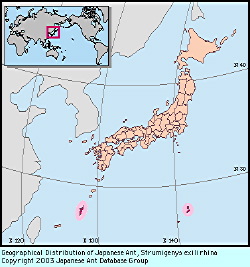
|
species
|
Strumigenys exilirhina
|
 |
Japanese Name
|
Kibabuto-uroko-ari
|
Original Reference
|
|
Bolton, B. (2000) The ant tribe Dacetini part 2. Memoirs of the American
Entomological Institute, 65: 492-1028.
|
Description
|
|
Total length of workers around 2 mm. Body color brown. Mandibles rather short and stout, less than half as long as head; their outer margins weakly convex. Ventral outline of head rather strongly convex. Most parts of mesothorax and propodeum smooth. Infradental lamellae of propodeum thin, about half as broad as propodeal spines, lacking spongiform appendage.
|
Remarks
|
|
The species is similar to Strumigenys sp. 5 [Kibanaga-uroko-ari], but separable in having relatively short and curved mandibles. Corresponding to Strumigenys sp. D of Onoyama (1976). Nests in the soil of open land and sugar-cane fields.
|
|

|
References
|
|
- Onoyama, K. (1976). A preliminary study of the ant fauna of Okinawa-Ken, with taxonomic notes. (Japan: Hymenoptera: Formicidae). . Ecol. Stud. Nat. Cons. Ryukyu Isl., 2, 121-141.
- Myrmecological Society of Japan, Editorial Committee (ed.) (Ed.). (1988). A list of the ants of Japan with common Japanese names. The Myrmecological Society of Japan, Tokyo.
|
Editor
|
|
Original text by Kazuo Ogata, Keiichi Onoyama and Mamoru Terayama. English translation by Kazuo Ogata, edited by Robert W. Taylor. Revised by Masashi Yoshimura.
|
|